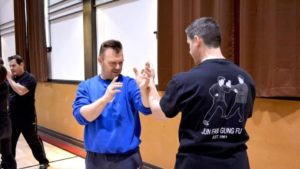BY DR BRYAN STOOPS
Class Structure
 In this section of this series of articles, I’m going to write about how and why I
In this section of this series of articles, I’m going to write about how and why I
teach the way I do. I am always interested in hearing how other martial arts instructors teach. I am interested in how Jun Fan and/or Jeet Kune Do Instructors teach, and I am interested in how instructors of multiple styles teach. Obviously, one needs to start somewhere, and an easy place to start is class scheduling. How often does/can the instructor offer class? This is an example from many years ago when I taught in Southern California in 2018. I taught twice a week in a park in La Verne, California (just about thirty miles inland of downtown Los Angeles).
That schedule was as follows:
Wednesdays:
5:30pm – 6:30pm: Youth Martial Arts Class
6:30pm – 7:15pm: Wing Chun Gung Fu,
7:15pm – 8:15pm: Jun Fan Gung Fu & Jeet Kune Do Core
8: 15pm – 9:45pm: Filipino Martial Arts Core
Saturdays:
11am – 12:15pm: Youth Martial Arts
12:15pm – 1:45pm: Silat Core
1:45pm – 3pm: Kickboxing
I am posting the schedule as an illustration of my trying to solve some things that have arisen recently in my practice. At that time, I had was just finishing my third year as a high school assistant principal. I’m not complaining, but the reality was that I worked a lot of hours at my full-time job (remember, my line is I am a proud semi-professional martial arts instructor). That schedule allowed me to teach around my job. Martial arts comes in right behind my family/friends and my career in the hierarchy of my life. I cannot imagine a version of my life without martial arts in it. Second, I have come into an interesting point in my practice: I have more material to teach than time to teach it. My core programs are Jun Fan/Jeet Kune Do, the Filipino Martial Arts, and Silat. I can rank my people in Wing Chun under Sifu Francis Fong, and the first few levels of the new(er) Dog Brothers Dog Tag Rankings. My Kickboxing curriculum is a blend of western boxing, Savate, and Thai Boxing all through a martial athletics lens. I will state explicitly that I wrote my Kickboxing curriculum to better teach those arts in one blend for the sake of time, and not to be a poor man’s STX, nor to rip off Coach Eric Paulson (one of the geniuses and innovators in our lineage). At this point in time, I had been working with Master Kirk McKune of Bahala Na for a few months trying to represent Master Kirk’s teaching in a training group leader capacity and I had been trying to train with Grand Tuhon Gaje and his senior representatives for few years previously. If one is reading that and thinking, “Why on earth would you be learning other systems when you don’t have time for everything currently on your plate?”, that is a fair question. My answer is that continuing my perpetual practice as a student is what has been modeled for me, what I try to model for my students, and (not to get too esoteric) I have faith that I am on the right path and it will all work itself out. Let me end this subsection by writing that the schedule above worked for me at that time. I have many friends far more financially successful than me that swear by shorter classes, no matter how many days a week they offer.
To Talk or Not to Talk
I consider Dan Inosanto as my primary instructor. I like to be transparent, so I will share that due to the nature of my work at that time, the previous three academic years had been lean in terms of how many many hours of instruction I received from Guro Inosanto. I have no problem writing that I know others have given up more and come further than I had to train with Guro. At that point, I was doing what I could. Around thirteen years ago, one of my senior students at the time attended the annual Train with the Legends seminar, and that seminar was that student’s first time training with Guro. On the drive home, my student said, “You know, I really understand more about why you teach the way you teach now.” A few minutes of silence went by, and I was riding a pretty great martial arts high and thinking about what my student had said. Just when I was ready to reply, he said, “I see all of their influence on you (all of the other instructors at the seminar), but I really see Guro’s influence on you. Now I really understand what you mean when you share in class that you hope you’re not talking too much.” We faced about an hour’s ride home, so the conversation continued, and I’m sure the remainder of the conversation was focused on martial arts. That student and I always had an easy time talking about martial arts, growing up, family, etc., so I’m certain the remainder of the conversation was pleasant. I don’t remember any more of it than what I have shared in the paragraph above. I can talk about martial arts (or for the matter, any topic about which I am passionate) for hours. Guro has written and spoken about when he would attend Bruce Lee’s classes hoping to work out hard, and Lee would lecture for the entire duration of class, or when Guro was tired and hoping for a light class, and Lee would work the group to exhaustion. What I know for certain is that I am not Dan Inosanto, and I am not trying to be some approximation of Dan Inosanto. But Guro blends history, anthropology, sports metaphors, personal training anecdotes, and so many other ideas expressed verbally into his teaching. So do a lot of his high level instructors, and the other instructors under the Inosanto umbrella. It’s hard (for me) not to offer my students my version of the same experience of learning from that information. I continue to examine this issue in my practice.
Class Structure
 – Does the head instructor bow the class in, or bring the class to a start (and a close) in some way?
– Does the head instructor bow the class in, or bring the class to a start (and a close) in some way?
– Are drills demo-ed by the instructor and a senior student, or the instructor and a student who might be under consideration for a promotion?
– Once the demo is complete, does the instructor give the students a predetermined amount of time to practice the drill while the instructor moves from student to student, or pair to pair, offering help? How rapidly does the instructor from drill to drill/concept to concept?
– What percentage of demonstrated proficiency is the instructor willing to accept before moving on?
– Does the class end with sparring/rolling/some form of contested practice of the techniques/concepts taught?
The questions above roughly cover the structure I have observed training at a multitude of schools/classes/seminars/workshops/ certifications across the country over the last twenty plus years. Below are a few ideas I have used, and seen used within this structure:
– Teaching Station
In both of the light industrial spaces out of which I have taught, and in my garage academy, I have had a teaching station. This is one area of the training space in which I had a table set up with my equipment, the timer, etc. to help me teach class. I have taught in a park and there I didn’t really have a formal teaching station, but I have noticed many instructors gravitate towards the use of a teaching station.
– Group Notes
When I notice several students making a similar mistake, it’s often a good time
to have everyone pause and take note of the error. I struggle with punitive consequences when teaching adults whereas I have a bit of an easier time with such things when teaching children because, frankly, I know the parents are expecting some push-ups and other consequences every class. The reason I am sharing this is that usually when I give group notes, I will start by saying something like, “I see a few of you doing the following…” That’s just my style. Calling individual students out by name doesn’t really fit my classroom/ academy culture. By no means am I writing that such concepts can’t be successful; they just do not fit me.
– Pitfalls and Mnemonics
This last idea really only comes with time. I am fortunate that I have been teaching martial arts part time for many years. There are many pieces of my curriculum(s) for which I can say to my students, “Okay, I’ve taught this to enough people that I can share, the following is the most common error you are about to make…” I also freely share any mnemonics/tricks that help me remember blocks of curriculum, and I encourage my students to develop their own if they don’t like mine and share those new mnemonics/tricks with the class. This helps all of my students feel like they are a part of a culture of learning.
PART 3 COMING SOON
Brian Stoops is a New York based martial arts instructor with teaching credentials in Jeet Kune Do, Filipino Martial Arts, Muay Thai and Silat.
